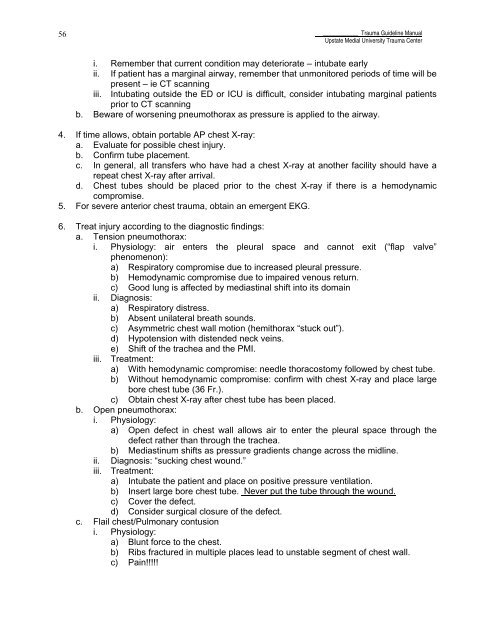Trauma Guideline Manual - SUNY Upstate Medical University
Trauma Guideline Manual - SUNY Upstate Medical University
Trauma Guideline Manual - SUNY Upstate Medical University
Create successful ePaper yourself
Turn your PDF publications into a flip-book with our unique Google optimized e-Paper software.
56____________ <strong>Trauma</strong> <strong>Guideline</strong> <strong>Manual</strong><strong>Upstate</strong> Medial <strong>University</strong> <strong>Trauma</strong> Centeri. Remember that current condition may deteriorate – intubate earlyii. If patient has a marginal airway, remember that unmonitored periods of time will bepresent – ie CT scanningiii. Intubating outside the ED or ICU is difficult, consider intubating marginal patientsprior to CT scanningb. Beware of worsening pneumothorax as pressure is applied to the airway.4. If time allows, obtain portable AP chest X-ray:a. Evaluate for possible chest injury.b. Confirm tube placement.c. In general, all transfers who have had a chest X-ray at another facility should have arepeat chest X-ray after arrival.d. Chest tubes should be placed prior to the chest X-ray if there is a hemodynamiccompromise.5. For severe anterior chest trauma, obtain an emergent EKG.6. Treat injury according to the diagnostic findings:a. Tension pneumothorax:i. Physiology: air enters the pleural space and cannot exit (“flap valve”phenomenon):a) Respiratory compromise due to increased pleural pressure.b) Hemodynamic compromise due to impaired venous return.c) Good lung is affected by mediastinal shift into its domainii.Diagnosis:a) Respiratory distress.b) Absent unilateral breath sounds.c) Asymmetric chest wall motion (hemithorax “stuck out”).d) Hypotension with distended neck veins.e) Shift of the trachea and the PMI.iii. Treatment:a) With hemodynamic compromise: needle thoracostomy followed by chest tube.b) Without hemodynamic compromise: confirm with chest X-ray and place largebore chest tube (36 Fr.).c) Obtain chest X-ray after chest tube has been placed.b. Open pneumothorax:i. Physiology:a) Open defect in chest wall allows air to enter the pleural space through thedefect rather than through the trachea.b) Mediastinum shifts as pressure gradients change across the midline.ii. Diagnosis: “sucking chest wound.”iii. Treatment:a) Intubate the patient and place on positive pressure ventilation.b) Insert large bore chest tube. Never put the tube through the wound.c) Cover the defect.d) Consider surgical closure of the defect.c. Flail chest/Pulmonary contusioni. Physiology:a) Blunt force to the chest.b) Ribs fractured in multiple places lead to unstable segment of chest wall.c) Pain!!!!!
















